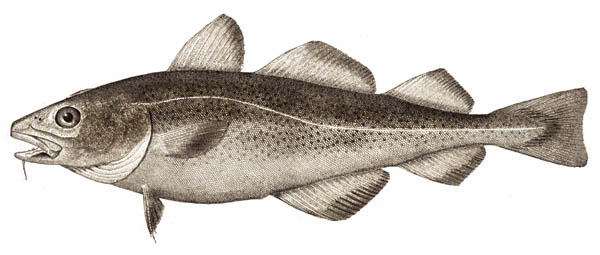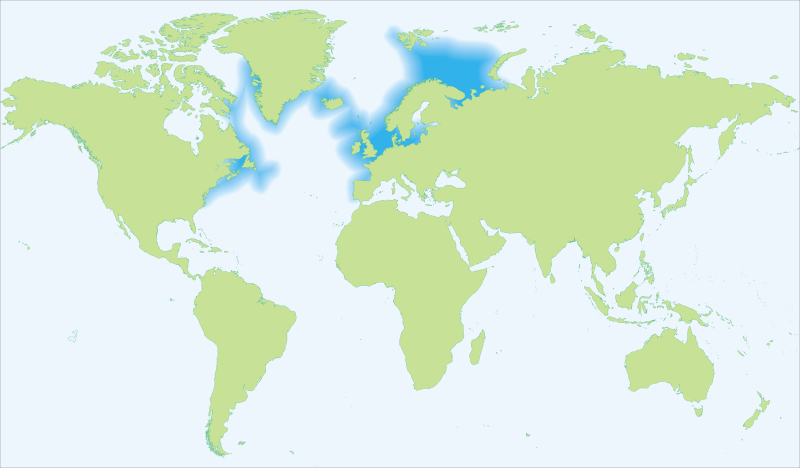Cod

Scientific Name: Gadus morhua
Also known as: Green, codling
MCRS: 35cm
Description
Cod are a typical round fish shape however; unusually they have three dorsal fins and two anal fins. They also have a distinctive chin barbel and the upper jaw overhangs the lower. They have a prominently curved lateral line which is whitish in colour and have a broom shaped tail. Their colour can vary depending on habitat but most are mottled brown with white bellies and spots with smooth small scales.
Habitat and Distribution

© I, Aotearoa CC-BY-SA-3.0, via Wikimedia Commons
Cod are found around all coasts of Britain and Ireland. Their distribution ranges from North Carolina to Greenland in the western Atlantic and from the Bay of Biscay to the Barents Sea in the eastern Atlantic and throughout the North Sea. They can tolerate temperatures from 0°C to over 20°C. Cod are commonly found over sandy bottoms from the shoreline down to 600m. Cod are commonly present in UK waters in autumn and winter although some remain in the UK all year round.
Life Cycle, Reproduction and Feeding
Growth and age/size at sexual maturity can differ between stocks with some reaching sexual maturity at 2-4 years (40 cm) and others at 6-9 years (60 cm). Cod exhibit courtship behaviour before spawning involving a fin display and grunting by the males, they then move to the surface and swim in circles. Spawning occurs in batches usually between December and June; cod can produce up to 20 batches during this period releasing 3 to 6 million eggs (depending on the size of the female) into the water column. The eggs form part of the plankton and hatch after around 2 weeks. Larval stages are carried in the plankton for up to 2 months before coming juvenile fish and moving towards the sea bed to start schooling, juveniles are known as ‘codling’. Once cod reach around 10 kg they move away from shallow, coastal areas to feed in the open sea and can live up to 25 years.
Cod are omnivorous and consume a variety of prey, with crustaceans and fish forming the main part of their diet. They go out to the open sea to feed on other fish such as herring, capelin, haddock and other cod. Most of their feeding activity occurs at dawn or dusk.
Additional Information
Cod behaviour varies between stocks; some stocks undertake large migrations between feeding in the open ocean and spawning in coastal areas, while other stocks can be quite stationary throughout their lives.
In the NWIFCA District
Cod is fished commercially within the district using demersal trawls, such as otter trawls, and using fixed or drift nets. It can also be caught using rod and line. Fishing for cod usually occurs in from October/November, when cod returns to UK waters, and throughout the winter. Over the last few decades both catches and spawning stock biomass have substantially declined in the Irish Sea. Effort has been made to recover the Irish Sea stocks and strict TAC quota regulations have been in place over recent years. As such, cod is less likely to be a target species and more likely landed as bycatch in static net and trawl fisheries targeting flatfish.
Recreational angling for cod is popular within the district both from shore and boat. Cod can be found across every different type of seabed and can therefore be caught form a wide range of places. Chartered angling boats are popular for catching cod and many operate off the coast of the southern part of the district.
Fisheries Management
Within the district there are byelaws to restrict the use and dimensions of nets and trawls, as well as vessel specifications including engine size and vessel length. These vary in different location throughout the district. To read more about this click here.
There are also national and international measures that apply to this fishery, as Irish Sea cod stocks have decreased in recent decades an annual total allowable catch (TAC) has been set for the species. TACs are divided up at an international level in the form of quotas and boats that are eligible are given a proportion of this quota and can fish for the species. Once the available quota has been fished the fishery is closed. To read more about this click here.
Where commercial trawling and netting occurs in MPAs it undergoes an assessment to ensure the activity does not cause risk to conservation features. HRAs carried out for trawling and netting in the district’s EMSs can be found here.